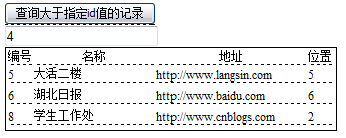Ext.XTemplate
Ext.onReady(function(){
//数据源
var data={
name:"博客园",
read:[{
book:'<<道不远人>>',
date:'2007-7-7'
},{
book:"<<大话设计模式>>",
date:"2006-6-6"
}]
}
//呈现组件
var mypanel=new Ext.Panel({
width:400,
id:"mypanel",
title:"XtemplateData简单示例",
renderTo:Ext.getBody()
});
//创建模板
var tpl=new Ext.XTemplate(
'<table><tr><th>名称:{name}</th></tr>',
'<tr><td>',
'<tpl for="read">',
'<p>编号:{#},书:{book},日期:{date}</p>',
'</tpl></td></tr></table>'
);
//重写绑定模板
tpl.overwrite(mypanel.body,data);
})
简要说明:
<!--<br /><br />Code highlighting produced by Actipro CodeHighlighter (freeware)<br />http://www.CodeHighlighter.com/<br /><br />-->
/*
var tpl=new Ext.XTemplate(
'<table><tr><th>名称:{name}</th></tr>',
'<tr><td>',
'<tpl for="read">',
'<p>编号:{#},书:{book},日期:{date}</p>',
'</tpl></td></tr></table>'
);
tpl.compile();
tpl.overwrite(mypanel.body,data);
*/
1 .tpl.compile(); // 可以在创建模板后,添加tpl.compile();编译代码,速度快点.
2 . tpl.overwrite(mypanel.body,data); // 把数据填充到模板中去,并呈现到目标组件
3 .名称:{name} // 对于一维单数据对象,直接用{名称}输出,
4 ., < tpl for = " read " > // 对于多维对象(如拥有多条数据的表),使用tpl和for配合使用,会使用tpl的格式把数据一条一条输出,read为上级节点
5 .{.} // 对于一维对数据的对象,如color: ['Red', 'Blue', 'Black'],可以用{.}按照tpl模板逐一输出,如:
' <tpl for="color"> ' ,
' <div> {.}</div> ' ,
' </tpl> '
6 .{#} // 表示循环的索引
7 .parent. *** // 在子对象中访问父对象元素,使用parent,如:{parent.name}
8 . if // '<tpl if="age > 1">',
' <p>{name}</p> ' ,
' </tpl> ' ,
// if实现有条件的逻辑判断,很容易使用
9 .其他几个常用的参数:
xindex // 循环模板的当前索引index(从1开始),用[]。
xcount // 循环模板循环的次数。 用[]
举例:
' <tpl for="read"> ' ,
' <p>编号:{#},书:{book},日期:{date},奇偶:{[xindex%2==0?"偶数":"奇数"]},次数:{[xcount]}</p> ' ,
' </tpl>
10.模板成员函数(借用api下):
var tpl = new Ext.XTemplate(
' < tpl for = " kids " > ' ,
' < tpl if = " this.isGirl(name) " > ' ,
' < p > Girl: {name} - {age} < / p>',
' </tpl> ' ,
' <tpl if="this.isGirl(name) == false"> ' ,
' <p>Boy: {name} - {age}</p> ' ,
' </tpl> ' ,
' </tpl></p> ' , {
isGirl: function (name){
return name == ' Sara Grace ' ;
},
isBaby: function (age){
return age < 1 ;
}
});
var tpl=new Ext.XTemplate(
'<table><tr><th>名称:{name}</th></tr>',
'<tr><td>',
'<tpl for="read">',
'<p>编号:{#},书:{book},日期:{date}</p>',
'</tpl></td></tr></table>'
);
tpl.compile();
tpl.overwrite(mypanel.body,data);
*/
1 .tpl.compile(); // 可以在创建模板后,添加tpl.compile();编译代码,速度快点.
2 . tpl.overwrite(mypanel.body,data); // 把数据填充到模板中去,并呈现到目标组件
3 .名称:{name} // 对于一维单数据对象,直接用{名称}输出,
4 ., < tpl for = " read " > // 对于多维对象(如拥有多条数据的表),使用tpl和for配合使用,会使用tpl的格式把数据一条一条输出,read为上级节点
5 .{.} // 对于一维对数据的对象,如color: ['Red', 'Blue', 'Black'],可以用{.}按照tpl模板逐一输出,如:
' <tpl for="color"> ' ,
' <div> {.}</div> ' ,
' </tpl> '
6 .{#} // 表示循环的索引
7 .parent. *** // 在子对象中访问父对象元素,使用parent,如:{parent.name}
8 . if // '<tpl if="age > 1">',
' <p>{name}</p> ' ,
' </tpl> ' ,
// if实现有条件的逻辑判断,很容易使用
9 .其他几个常用的参数:
xindex // 循环模板的当前索引index(从1开始),用[]。
xcount // 循环模板循环的次数。 用[]
举例:
' <tpl for="read"> ' ,
' <p>编号:{#},书:{book},日期:{date},奇偶:{[xindex%2==0?"偶数":"奇数"]},次数:{[xcount]}</p> ' ,
' </tpl>
10.模板成员函数(借用api下):
var tpl = new Ext.XTemplate(
' < tpl for = " kids " > ' ,
' < tpl if = " this.isGirl(name) " > ' ,
' < p > Girl: {name} - {age} < / p>',
' </tpl> ' ,
' <tpl if="this.isGirl(name) == false"> ' ,
' <p>Boy: {name} - {age}</p> ' ,
' </tpl> ' ,
' </tpl></p> ' , {
isGirl: function (name){
return name == ' Sara Grace ' ;
},
isBaby: function (age){
return age < 1 ;
}
});
接下来,我们做个服务器的例子(好像很多朋友对这个要求很强烈啊)
实例演示:用模板呈现服务器数据
效果图:
html代码:
<!--<br /><br />Code highlighting produced by Actipro CodeHighlighter (freeware)<br />http://www.CodeHighlighter.com/<br /><br />-->
<
div
id
="container"
>
</ div >
</ div >
css代码:
<!--<br /><br />Code highlighting produced by Actipro CodeHighlighter (freeware)<br />http://www.CodeHighlighter.com/<br /><br />-->
<
style
type
="text/css"
>
body
{
font-size : 12px
}
#container
{
border : 1px solid black ;
width : 330px ;
}
td,th
{
border-bottom : 1px dashed black ;
}
th
{
text-align : center ;
}
.namewidth
{
width : 120px ;
}
.urlwidth
{
width : 150px ;
}
</ style >
body
{
font-size : 12px
}
#container
{
border : 1px solid black ;
width : 330px ;
}
td,th
{
border-bottom : 1px dashed black ;
}
th
{
text-align : center ;
}
.namewidth
{
width : 120px ;
}
.urlwidth
{
width : 150px ;
}
</ style >
js代码:
<!--<br /><br />Code highlighting produced by Actipro CodeHighlighter (freeware)<br />http://www.CodeHighlighter.com/<br /><br />-->
Ext.onReady(
function
(){
var mydata;
Ext.Ajax.request({
url: " getXtemplateData.ashx " , // 服务器端地址
success: function (request){
mydata = request.responseText; // 服务器端文本数据
mydata = eval( ' ( ' + mydata + ' ) ' ); // 使用eval把文本数据转换为json对象
//或者用extjs自带的方法:mydata=Ext.util.JSON.decode(mydata),效果相同
var tpl2 = new Ext.XTemplate(
' <table><thead><tr><th> 编号</th><th class="namewidth">名称</th>< th class="urlwidth">地址</th><th>位置</th></tr>& lt;/thead><tbody> ' ,
' <tpl for="results"> ' ,
' <tr><td>{#}</td><td>{linkname}</td><td>{linkurl}</td><td>{linkpos}</td><tr> ' ,
' </tpl></tbody></table> '
);
tpl2.compile();
tpl2.overwrite(Ext.get( " container " ),mydata);
},
failure: function ()
{
alert( " failure! " );
}
});
})
/* **简单说明***
1.Ext.Ajax.request(),这里暂且对ajax不多谈论,后面会详细叙述
2.eval用"()"可以把规范文本转换为json对象,很重要!mydata=eval('('+mydata+')');
3.如果我们把模板创建和绑定放到ajax外面,会出错,因为ajax为异步调用,记住哦~
4.关于success函数的request参数,我截个图看看,就明白了
*/
var mydata;
Ext.Ajax.request({
url: " getXtemplateData.ashx " , // 服务器端地址
success: function (request){
mydata = request.responseText; // 服务器端文本数据
mydata = eval( ' ( ' + mydata + ' ) ' ); // 使用eval把文本数据转换为json对象
//或者用extjs自带的方法:mydata=Ext.util.JSON.decode(mydata),效果相同
var tpl2 = new Ext.XTemplate(
' <table><thead><tr><th> 编号</th><th class="namewidth">名称</th>< th class="urlwidth">地址</th><th>位置</th></tr>& lt;/thead><tbody> ' ,
' <tpl for="results"> ' ,
' <tr><td>{#}</td><td>{linkname}</td><td>{linkurl}</td><td>{linkpos}</td><tr> ' ,
' </tpl></tbody></table> '
);
tpl2.compile();
tpl2.overwrite(Ext.get( " container " ),mydata);
},
failure: function ()
{
alert( " failure! " );
}
});
})
/* **简单说明***
1.Ext.Ajax.request(),这里暂且对ajax不多谈论,后面会详细叙述
2.eval用"()"可以把规范文本转换为json对象,很重要!mydata=eval('('+mydata+')');
3.如果我们把模板创建和绑定放到ajax外面,会出错,因为ajax为异步调用,记住哦~
4.关于success函数的request参数,我截个图看看,就明白了
*/